戦国時代のこの城の姿を伝える絵図が残っています。
A drawing shows the castle’s appearance in the Warring States.

立地と歴史~Location and History
村上城は、「臥牛山」という牛が臥せている形をした山にありました。この場所は、新潟県の北部にある村上市に所属しています。この城がいつ最初に築かれたかははっきりしません。戦国時代には本荘氏がこの城を所有していて、当時は本荘城と呼ばれていました。
Murakami Castle was located on a mountain called “Gagyu-San” which means a mountain which looks like a cow laying down. The place belongs to Murakami City in the northern part of Niigata Pref. It is uncertain when castle was first built. In the Warring States Period, the Honjo clan owned the castle which was then called Honjo Castle.
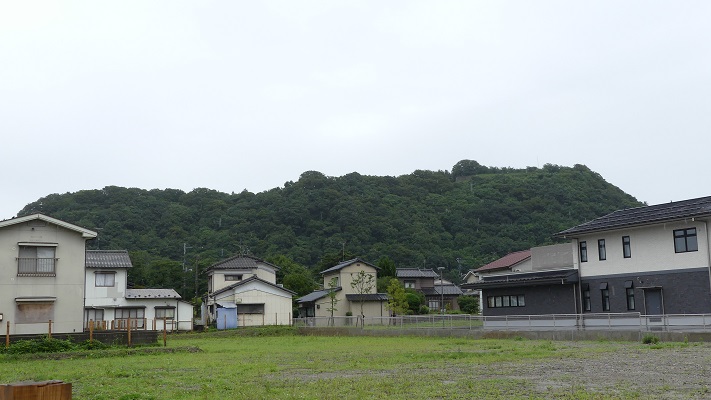
本荘繁長は、越後国(現在の新潟県)の有力戦国大名の上杉謙信に従っていました。ある時彼は独立を志し、謙信に反逆しました。謙信は無敵の武将とされており、城を取り囲みました。しかしこの城も難攻不落であり、約1年間耐え忍びました。ついには双方和睦を結びました。繁長はその後は上杉氏に献身的に仕え、十五里ヶ原の戦いでは最上氏を打ち破りました。ところが天下人の豊臣秀吉から、命令に背いたかどにより改易となってしまいます。
Shigenaga Honjo was under the great warlord in Echigo Province (what was now Niigata Pref.), Kenshin Uesugi. He once tried to be independent and rebelled against Kenshin. Kenshin who is considered invincible, surrounded the castle, but the castle which was also impregnable, stood for about a year. They finally made peace with each other. After that, Shigenaga was devoted to Uesugi. He defeated the Mogami clan in the battle of Jugorigahara. However, he was fired by the ruler Hideyoshi Toyotomi due to breaking Hideyoshi’s order.
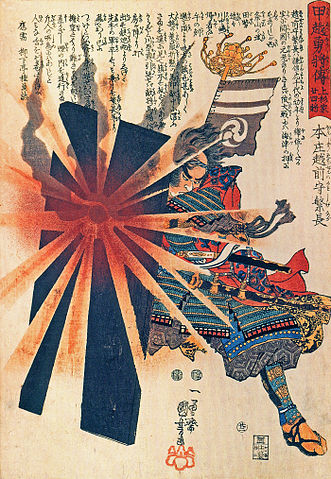
上杉氏は1598年に東北地方に移されるのですが、その移封の直前に領地の絵図面を作成し、新しい領地の方に持っていき、現在まで保管しています。そのうちの一つが越後国瀬波郡絵図です。村上城はこの絵図の中で「村上要害」(要害は砦といった意味)として描かれています。その絵図はこの城の戦国時代終わり頃の姿を伝えています。わが国の貴重な文物とされています。
Uesugi clan was transferred to the Tohoku region in 1598, but they created drawings of their territory just before the transfer, brought them to their new territory, and have kept them until now. One of them is called the drawing of Senami District in Echigo Province. Murakami Castle is in the drawing as “Murakami Yogai” (Yogai means stronghold). The drawing shows the appearance of the castle at the end of the Warring States Period. It is considered a very valuable material for the country.
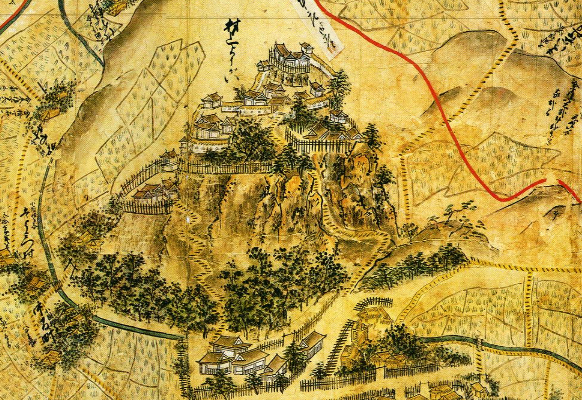
この絵図によれば、この城には天守はなく、石垣も白壁もなく、ただ柵に囲まれた土塁の曲輪の上に館があるだけです。それは、当時の東日本においては典型的な地方の城のスタイルでした。本荘氏の後は、村上、松平、そして内藤氏といった氏族がこの城を支配しました。この城は彼らの下で近代化されました。天守が山の頂に築かれ、多くの石垣も築かれ、城の範囲は山麓まで広がりました。江戸時代に描かれた「越後国村上城之絵図」を見るとそれがわかります。この城が中世と近世の間にどのように変わったのかがはっきりと見て取れます。
According to the drawing, the castle had no Tenshu, no stone walls and no plaster walls, just had halls on earthen enclosures surrounded by fences. That was a typical local castle style in eastern Japan at that time.
After Honjo clan, several clans like Murakami, Matsudaira, and Naito governed the castle. The castle was modernized under their governance. The Tenshu keep was built on the top of the mountain, a lot of stone walls were also built, and the range of the castle was spread to the foot of the mountain. “The illustration of Murakami Castle in Echigo Province” in the Edo Period shows them. We can clearly see how the castle had changed between the Middle and Modern Ages.

明治維新の間、村上藩の武士たちは新政府につくか旧幕府につくか逡巡していました。旧幕府側の支持者たちは城を退去し、東北地方の同志に合流すると決め、自ら城に放火してしまいました。
During the Meiji Restoration, warriors of the Murakami Domain were wondering if they should support the New Government or the former Shogunate. When the supporters of former Shogunate decided to withdraw the castle and join supporters in Tohoku region, they burn the castle by themselves.
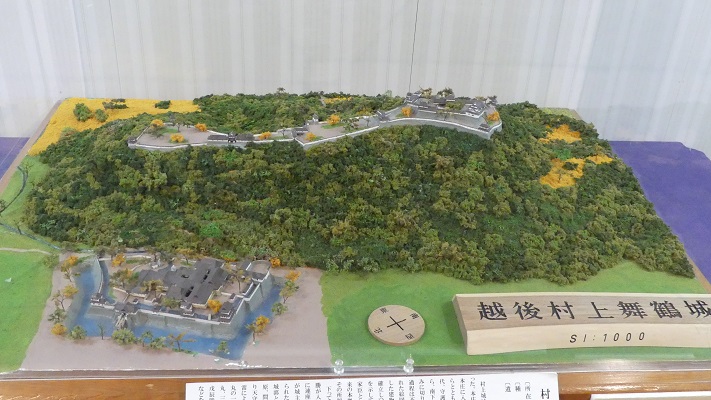
特徴~Features
それでは入口から城跡に向けて登ってみましょう。山道は「七曲り道」と呼ばれていて、曲がりくねった山道といった意味です。
Let’s climb up to the castle ruins from the entrance. The trail is called “Nanamagari-Michi” which means a winding trail.

道の傾斜が緩やかになっているので、登りやすくなっています。実は、この道の由来は戦国時代にさかのぼると言われています。
That makes it easier for visitors to climb because the trail becomes more gentle. In fact, this trail can be traced back to the Warring States Period.
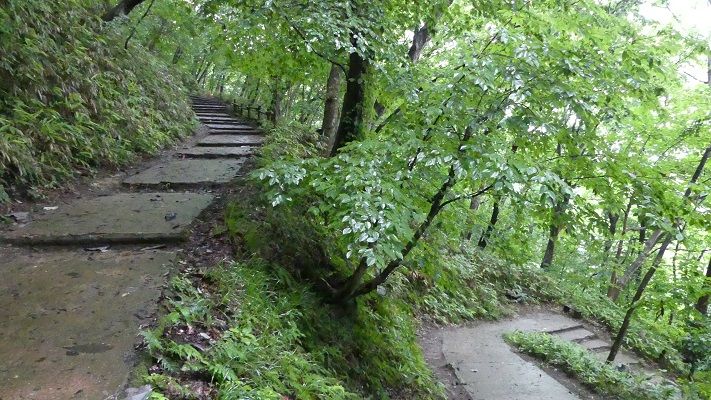
それは、先ほどの「越後国瀬波郡絵図」と「越後国村上城之絵図」両方に、恐らくは同じ場所であろう所に、似たような山道が描かれているからです。何か素晴らしく感じます。そうなってくると、敵が簡単に城を攻撃できてしまうのではないかとも感じます。歴史家によると、敵がこのような曲がりくねった道を登るときは、側面を防御側に見せてしまうため、かえって防御側に有利になるということです。
Becase you can see the similar trail at probably the same place in both of “the drawing of Senami Distinct” and “the illustration of Murakami Castle”. It’s amazing. You may ask that enemies might attack the castle easily. Some historian suggest that attackers will have their sides facing the defenders when climbing such a winding trail. It can be advantageous for the defenders.
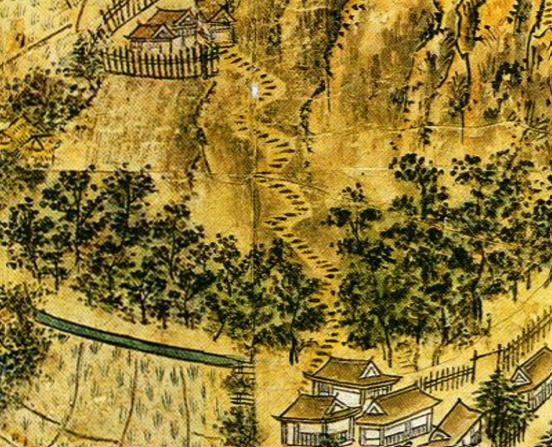
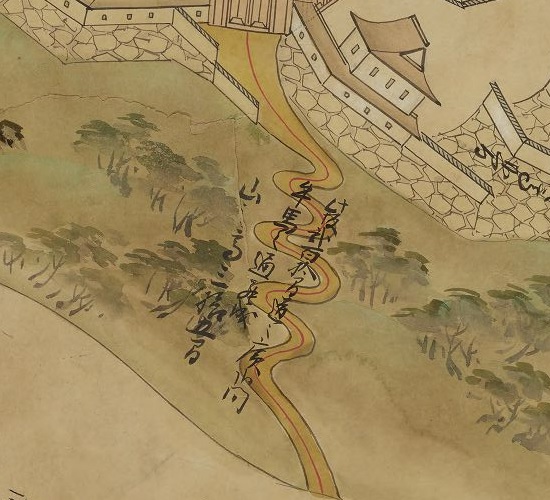
約15分ほどで山の上にある三の丸四つ門跡に到着します。
It will take about 15 minutes to reach the ruins of “Yottsu” gate at “Sannomaru” enclosure on the mountain.
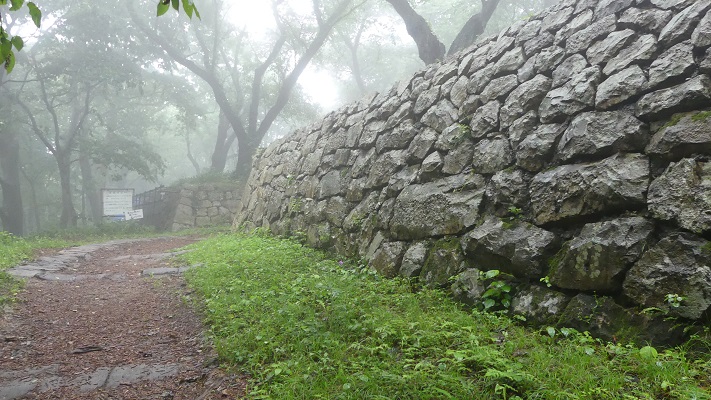
本丸の方に行くには、狭い二の丸を通らねばなりません。
You can head towards “Honmaru” enclosure passing through narrow “Ninomaru”.
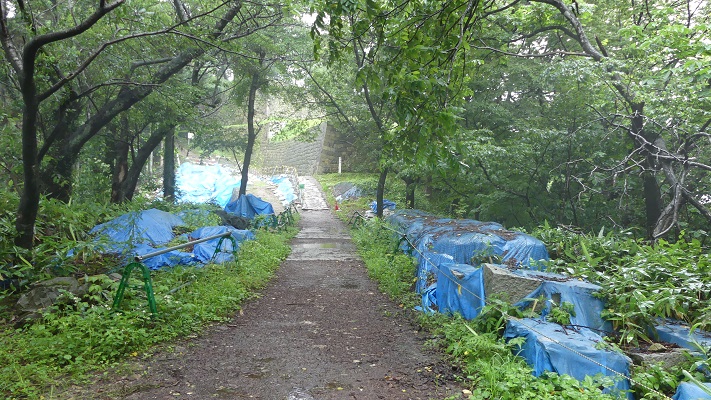
今に残る多くの石垣が見られます。全ての石垣は江戸時代に作られたものです。
A lot of remaining stone walls are there. They were all built in the Edo Period.
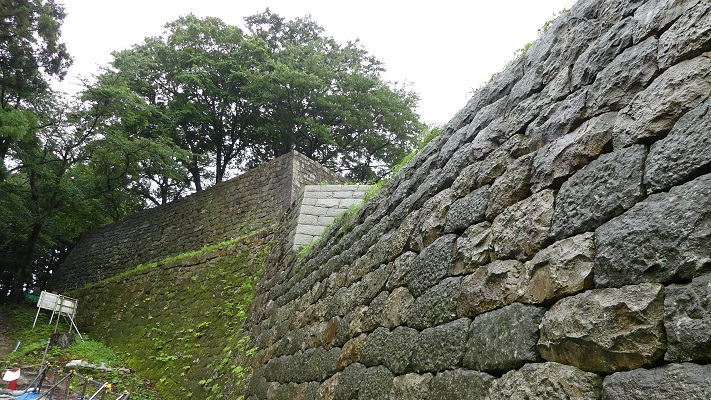
山の一部は現在発掘中です。戦国時代の遺跡が見つかるのではないかと言われています。
Part of the mountain is now under excavation. It is said that the ruins in the Warring States Period might be found.
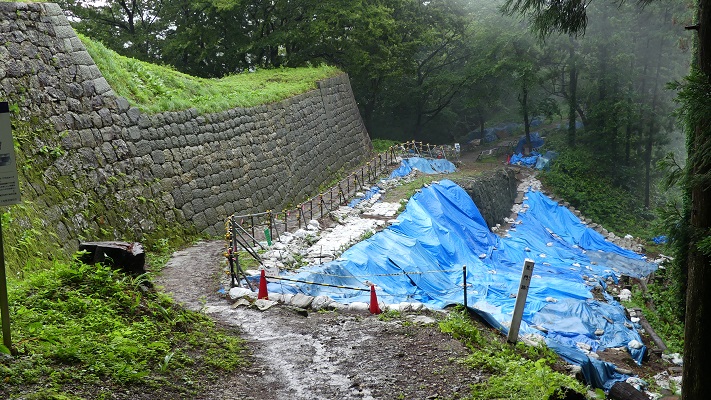
そうするうちに、山の頂にある天守台に到着します。そこからは村上市全域が一望できます。
You will soon reach the Tenshu base at the top of the mountain, and can see the whole view of Murakami City.
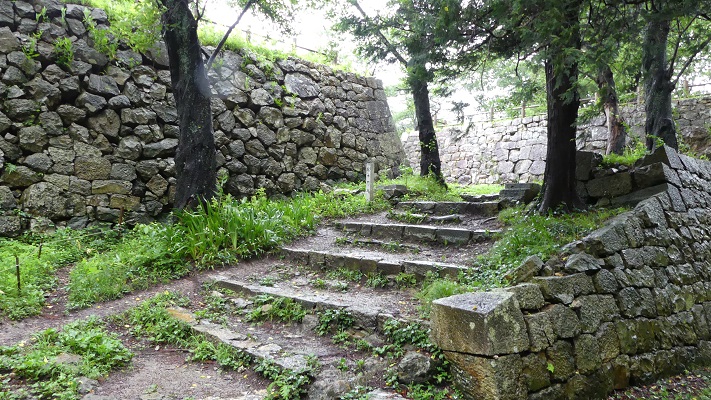
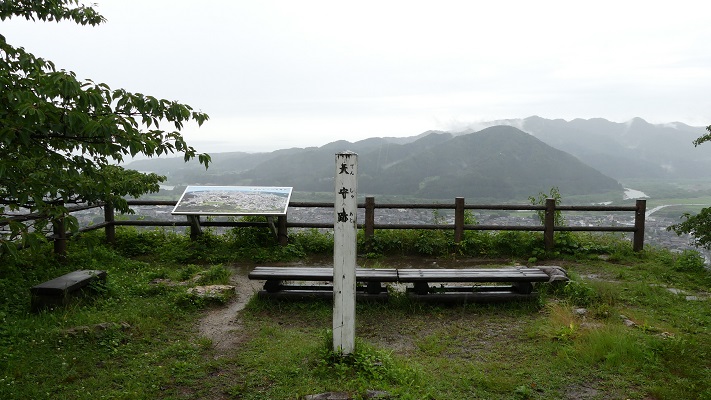
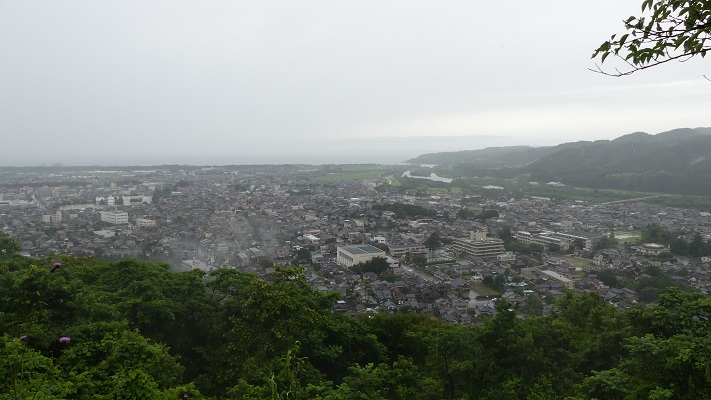
その後~Later Life
明治維新後、領主だった内藤氏は城の残りの建物と一部の石垣の売却を申し出て許されました。その後、藩士の子孫たちは城跡を維持してきました。1960年には県の史跡に指定され、1993年には国の史跡にもなりました。
After the Meiji restoration, the lord Naito applied for and was allowed to sell the rest of the buildings and part of the stone walls in the castle. After that, the descendants of the warriors has kept the ruins. They are designated as a Prefectural Historic Site in 1960. They also became a National Historic Site in 1993.

私の感想~My Impression
地元の人たちが「七曲り道」の山道を日頃の運動のために登ったり下ったりしているのを見ました。どうやら毎日頂上まで登って戻ってくるという感じでした。会ったときはお互いにあいさつをしていました。かつては戦いのために作られた古の道は、現在人々の健康やコミュニケーションのために使われているのです。素晴らしいことです。
I saw that local people were climbing up or down the trail “Nanamagari-Michi” for daily exercise. They seemed to reach the top and turn back everyday. They were also saying hello each other. the traditional trail, which was built for battle, is now used for people’s health and comminication. It’s amazing.

ここに行くには~How to get There
JR村上駅から歩いて30分近くかかります。
東京から村上駅まで:
上越新幹線に乗り、新潟駅でJR白新線に乗り換えてください。
車で行く場合:日本海東北自動車道村上瀬波温泉ICから10分以内、または村上駅から約5分。
城跡には駐車場はありますが、小さいのでよく満車になります。そのときは近くの村上市役所か村上郷土資料館に駐車してください。
It takes nearly 30 minutes From JR Murakami station to get there on foot.
From Tokyo to Murakami st.:
Take the Joetsu Shinkansen superexpress to Nigata station, and transfer for JR Hakushin line.
If you want to go there by car: It takes within 10 minutes from the Murakami-Senamionsen IC on Nihonkai-Tohoku Expressway, or about 5 minutes from Murakami station.
The ruins have a parking lot. But it’s small and can often be full. In that case, you can park at the Murakami City Hall or Murakami History Museum nearby.
リンク、参考情報~Links and References
・鮭、酒、人情(なさけ)むらかみ~Murakami city tourism association
・ビジュアル再現 村上城(Only Japanese)
・「甲信越の名城を歩く 新潟編」吉川弘文館(Japanese Book)
